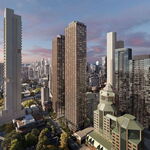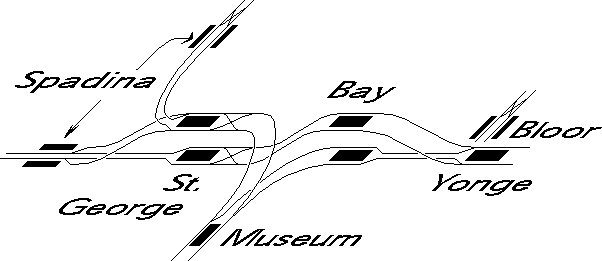Once again, your quality maps are only outdone by your innovative thinking.
Gracias!
I have yet to hear of a great plan for what to do with the Western leg, especially since it almost would follow the UP route. This solves that problem.
Yup, most western leg proposals either use Queen or King, and either curve up or curve down. Curving up pretty much anywhere except for Dufferin involves a duplication of existing GO infrastructure. This just basically says "forget it, we'll tailor another piece of infrastructure to do a better job". The advantage of using streetcars (which in this scenario would be functionally identical to LRT), is that the routes can continue far beyond where the tunnel infrastructure ends, creating connections (to Dundas West for example) that would cost billions if subway technology was used.
I also like interlining as a means of relieving Y-B. I think its much better for half the passengers to wait another 2 minutes (at some sparsely used station) for the proper train to arrive, than to have everyone transferring at the one interchange station.
Exactly. People would rather wait an extra couple of minutes for a one-seat ride, especially if it means those getting on at Kipling or Kennedy has a seat for their entire trip downtown. The frequencies during peak can be tailored to demand (ex: 2 trains downtown, 1 train thru).
This completely negates the need to spend $1 billion+ expanding Bloor-Yonge, money which can be spent on system expansion instead.
Now the downside - political reality.
One problem with the proposal - people are entitled. Those on Spadina north like being able to go directly to Union or King - and they're used to it. The DRL goes close to those locations, but its not the same. We also live in a world where the squeeky wheel get the grease. This helps the commute for those coming from the north, east, and west, but that would likely be overshadowed by the few complaints from the Spadina line neighborhoods that suffer a minor change in travel.
Acknowledged. The pitch I would use with them is that they'll no longer be crush loaded at St. George during peak, and the transfer volume at Spadina will be minimal (not very many people will be going from Dupont to Queen & Spadina). If they do need to reach Union, by the time the Yonge-University trains reach Osgoode, many people will have gotten off, so they won't be getting onto a packed train.
Even people who only have a vague promise of transit (i.e. Vaughan 8 years ago, Scarborough, Sheppard), they have already come to expect that what they will get is tunneled subway. That is the reason I thought a brand new "Scarborough Line" would be a good replacement for the "Scarborough Subway" (B-D extension). Adding transit to a new area, they have not yet formed their entitlement for a tunneled subway. You can make the arguement that it is elevated or nothing. You also have to have an alternate route so that if this group doesn't want the line (i.e. Ellesmere), then the other area (i.e. Lawrence or Gatineau) will get it. The option isn't elevated or tunneled, because then locals will always demand tunneled. The option is elevated or nothing.
That's a good point. To a large extent, this alignment doesn't negate that. I've shown the Spadina-Pape line terminating at Pape, but it could just as easily be extended north of the Danforth on any number of alignments. I just figured that was a whole other scope that wasn't related to the downtown solutions that I was proposing here.
It would be better if the Yonge-University line terminated at Spadina Station during off-peak.
I had thought about that, but the issue is that if it were to terminate at Spadina, it would be parking trains on live tracks (using either the Bloor or Spadina platforms). With St. George, you'd have the upper level reserved exclusively for parking and turning, whereas the lower level would be the live Bloor-Danforth tracks. In short, by short-turning there you don't impact Bloor-Danforth or Spadina-Pape operations at all. It's unfortunate, but rectifying that situation would mean a pretty expensive alteration.
Another option would be adding a 3rd track to Spadina (Bloor) either on the north or south side, and creating a 3 track, 2 platform station, where the middle track would be the turning track, and the 2 outer tracks would be the Bloor-Danforth thru tracks. But again, that's a pretty expensive solution. You may be able to couple that project in with the demolition of the redundant streetcar loop though.











